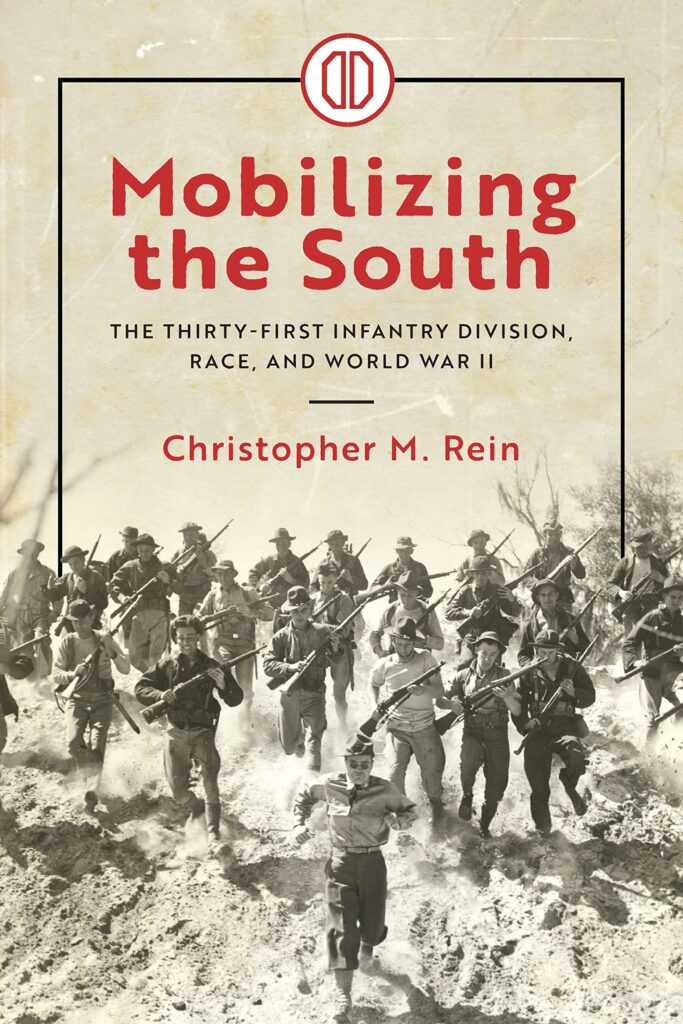By Christopher M. Rein.
Tuscaloosa: University of Alabama Press, 2022.
ISBN 978-0-8173-2134-5. Photographs. Notes. Bibliography. Index.
Pp. 344..$59.95.
In Mobilizing the South, Christopher Rein presents an honest and scholarly assessment of an infantry division primarily made up of citizen-soldiers from the southern United States. The book chronologically follows the 31st Infantry Division from its organization in 1917, through World War II (its primary focus), and into the 1960s when the division was inactivated. Central to his thesis is the systemic racism that permeated from civilian to Army life. This should not be surprising in a division made up of Southern soldiers whose officers represented the social and economic elite during the time of Jim Crow laws.
While the theme of racial inequality is central to Mobilizing the South, Rein also investigates a largely unwritten period in the South’s National Guard history. This is not simply an account of heroics in battle. This is a nuanced examination of the division and its place in southern society. The division’s leaders and soldiers are shown in the complex way in which humans exist. There are those, such as the commanding general, Major General John C. Persons, who are competent managers and politically adept, and yet show extraordinary failings in their racist views and actions. Persons was one of only a few National Guard generals who remained in command of their division after the National Guard was mobilized in 1940.
At once, readers should be critical of the racism that the unit embraced. Yet, they may also sympathize with the characters who were underdogs in a wartime Army dominated by West Point officers who generally looked down upon citizen-soldiers.
These character examinations shine a whole new light onto World War II-era National Guard leaders from the Southern states, many of whom are honored as the namesakes of training camps and leadership awards, such as Major General Sumter Lowry of the Florida National Guard. While the Florida National Guard’s Lowry Leadership Award is among its most prestigious state awards, few in the Guard know anything about Lowry’s actual contributions to the National Guard. In fact, if historians remember Lowry for anything, it is his unsuccessful postwar gubernatorial race in which he ran on a single issue: to keep blacks out of white schools.
Mobilizing the South also provides insight into the National Guard at large and the process of increased federalization over the years. This increased federal oversight came as Congress and the Army demanded better preparation for war, to make the National Guard a more valuable organization, and to fight off those in the Regular Army establishment who lobbied for the disbandment of the Guard. This naturally led to fewer political officers (since the federal government had final approval of commissions and promotions) and the eventual exclusion of the Ku Klux Klan (whose leanings, if not membership, were once prominent among southern Guard troops). This also led to the inclusion of black men, although not until the late 1960s in the Deep South, some twenty years after Truman announced desegregation of the military in 1948.
Rein’s work shows that all was not wholesome in the Army that defeated the Axis Powers of Germany, Italy, and Japan. While this book focuses on race in this Southern division, there were racial problems throughout the entire army. If only more historical studies were so critical of the protagonists, to show their complexities and biases, how they can be both heroic and unjust. Mobilizing the South contributes to the growing histories that delve into some of the darker parts of the American effort in World War II. This book should be of great interest to readers interested in the history of the National Guard, race and the military, the American South, or World War II.
Lieutenant Colonel Ryan Hovatter, USA
Springfield, Virginia
